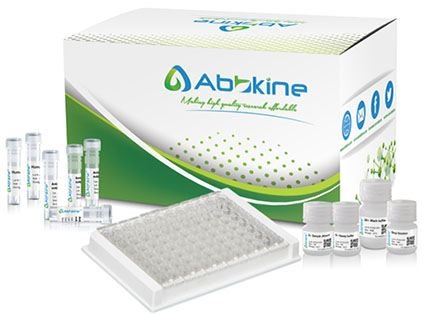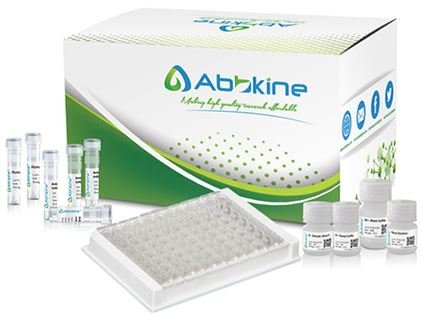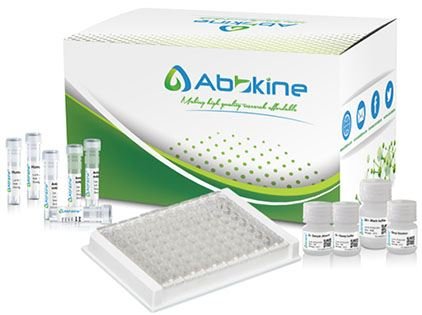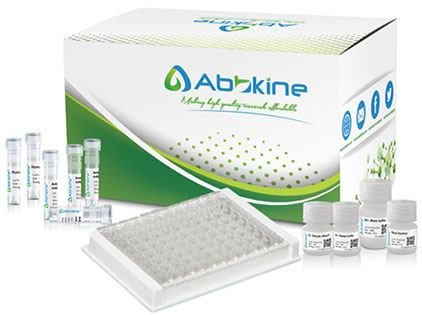Abbkine Scientific ELISA Kits
Abbkine Scientific ELISA Kits
Manufacturer: Abbkine Scientific
The product listed herein is for research use only and is not intended for use in human or clinical diagnosis. Suggested applications of our products are not recommendations to use our products in violation of any patent or as a license. We cannot be responsible for patent infringements or other violations that may occur with the use of this product.
Manufacturer: Abbkine Scientific
Monocyte/neutrophil elastase inhibitor (EI) is a protein of approximately 42,000 Mr with serpin-like functional properties. Remold-O'Donnell et al. (1992) cloned EI cDNA and identified 3 EI mRNA species of 1.5, 1.9, and 2.6 kb in monocyte-like cells and no hybridizing mRNA in lymphoblastoid cells lacking detectable EI enzymatic activity. The cDNA open reading frame encoded a 379-amino acid protein. Its sequence established EI as a member of the serpin superfamily. Sequence alignment indicated that the reactive center P1 residue is cys-344, consistent with abrogation of elastase inhibitory activity by iodoacetamide and making EI a naturally occurring cys-serpin. Other elastase inhibitors include alpha-1-antitrypsin (PI) and secretory leukocyte protease inhibitor (SLPI).
Manufacturer: Abbkine Scientific
Prolactin-releasing hormone, also known as PRLH, is a hypothetical human hormone or hormone releasing factor. Existence of this factor has been hypothesized as prolactin is the only currently known hormone for which almost exclusively negative regulating factors are known (such as dopamine, leukemia inhibitory factor, some prostaglandins) but few stimulating factors. While many prolactin stimulating and enhancing factors are well known (such as thyrotropin-releasing hormone, oxytocin, vasoactive intestinal peptide and estrogen) those have primary functions other than stimulating prolactin release and the search for hypothetical releasing factor or factors continues. The prolactin-releasing peptide identified in 1998 was a candidate for this function, however as of 2008 it appears its function is not yet completely elucidated.
Manufacturer: Abbkine Scientific
Tenascinis an extracellular matrix protein with a spatially and temporally restricted tissue distribution. It is a hexomeric, multidomain protein with disulfide-linked subunits of 190 to 240 kD, originally characterized as 'myotendinous antigen.' In the embryo it is present in dense mesenchyme surrounding developing epithelia, in tendon anlagen, and in developing cartilage and bone. In the adult tenascin remains present in tendons and myotendinous junctions in the perichondrium and periosteum, as well as in smooth muscle. Pearson et al. (1988) isolated cDNA clones coding for tenascin from a chicken fibroblast cDNA expression library using a specific tenascin antiserum. They showed induction of tenascin in vitro by fetal calf serum as well as by transforming growth factor-beta .
Manufacturer: Abbkine Scientific
The product listed herein is for research use only and is not intended for use in human or clinical diagnosis. Suggested applications of our products are not recommendations to use our products in violation of any patent or as a license. We cannot be responsible for patent infringements or other violations that may occur with the use of this product.
Manufacturer: Abbkine Scientific
The olfactory system provides a unique model for developmental neurobiology. Olfactorin is a secreted modular protein containing several domains typically present in extracellular matrix proteins. During embryonic development expression of the Umodl1 gene is detectable only in the olfactory epithelium and vomeronasal organ starting at embryonic day 16.5. At this stage, Umodl1 expression within the olfactory epithelium is punctate, and is restricted to only some of the sensory neurons. At birth and postnatally, expression in these organs continues and involves more neurons. Kallmann syndrome is a genetic disease in which olfactory axons fail to connect to target neurons in the bulb.Olfactorin may play a role in correct olfactory axon navigation to the brain.
Manufacturer: Abbkine Scientific
Vascular endothelial growth factor B is a growth factor that belongs to the vascular endothelial growth factor family of which VEGF-A is the best known member. In contrast to VEGF-A, VEGF-B plays a less pronounced role in the vascular system: whereas VEGF-A is important for the formation of blood vessels, such as during development or in pathological conditions, VEGF-B seems only to play in role in the maintenance of newly formed blood vessels during pathological conditions. VEGF-B plays also an important role on several types of neurons. It is important for the protection of neurons in the retina and the cerebral cortex during stroke and of motoneurons during motor neuron diseases such as amyotrophic lateral sclerosis.VEGF-B exerts its effects via the FLT1 receptor.
Manufacturer: Abbkine Scientific
S100A8, a protein associated with a wide variety of inflammatory conditions, is heavily over-expressed in association with inflammation. Human S100A8 possesses neutrophil-repelling properties that result in an anti-inflammatory effect in vivo. The chemotactic activity of S100A8 on neutrophils was tested in Transwell chemotaxis assays. Analysis of the data indicates that S100A8 causes a repulsion of peripheral neutrophils, an activity that S100A8 loses upon its oxidation. S100A8 causes a strong anti-inflammatory effect in the rat air-pouch model of inflammation in vivo. These data highlight a naturally occurring novel anti-inflammatory pathway and provide potential molecular targets for the development of novel anti-inflammatory therapeutics.
Manufacturer: Abbkine Scientific
The product listed herein is for research use only and is not intended for use in human or clinical diagnosis. Suggested applications of our products are not recommendations to use our products in violation of any patent or as a license. We cannot be responsible for patent infringements or other violations that may occur with the use of this product.









